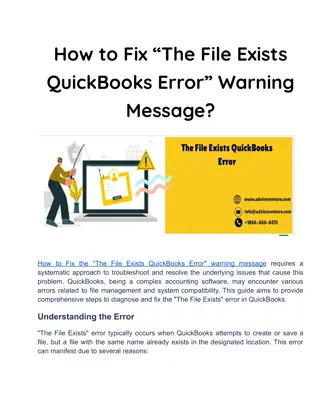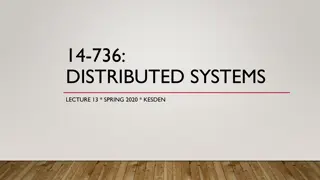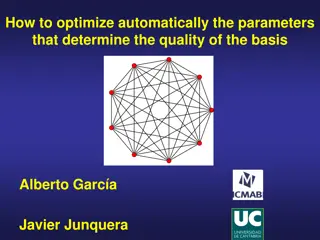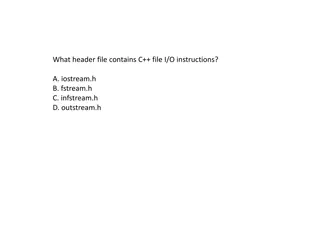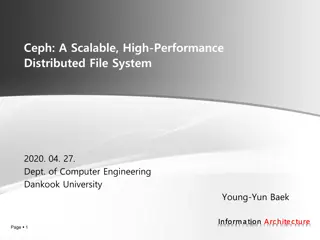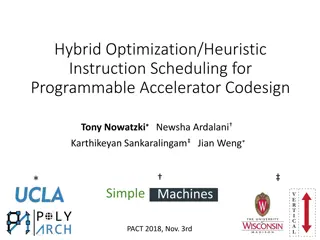Understanding File System Performance and Optimization Techniques
This content covers important topics related to file systems, such as improving system performance, preventing internal fragmentation, selecting block sizes, and organizing data blocks. Various file system case studies are discussed, including FFS and LFS, along with key concepts like super blocks, inodes, and data block storage. Insights on creating and traversing directories, allocating and populating inodes, and initializing data blocks are provided.
Download Presentation

Please find below an Image/Link to download the presentation.
The content on the website is provided AS IS for your information and personal use only. It may not be sold, licensed, or shared on other websites without obtaining consent from the author. Download presentation by click this link. If you encounter any issues during the download, it is possible that the publisher has removed the file from their server.
E N D
Presentation Transcript
Announcements P3 Grading: Available Look at runtests.log for details (10 points for creating test cases) Contact TA (give login and discussion section) with questions P4: Threads (Part a and b) available Due Wednesday 11/18 at 9pm Exam 2: Answers with explanations available Exam 3: Thursday evening at 11/19 7:15-9:15 Fill out form AND send academic schedule if need alternate time by 5pm Similar in style to previous exams (very few questions about Virtualization; few about Concurrency) Read as we go along! Chapter 41
UNIVERSITY of WISCONSIN-MADISON Computer Sciences Department CS 537 Introduction to Operating Systems Andrea C. Arpaci-Dusseau Remzi H. Arpaci-Dusseau Persistence: FAST FILE SYSTEM (FFS) Questions answered in this lecture: How to improve performance of complex system? Why do file systems obtain worse performance over time? How to choose the right block size? How to avoid internal fragmentation? How to place related blocks close to one another on disk?
File-System Case Studies Local - FFS: Fast File System - LFS: Log-Structured File System Network - NFS: Network File System - AFS: Andrew File System
Review: Basic Layout super block bit inodes Data Blocks maps 0 N regular data directories indirect blocks inodes data blocks What is stored as a data block?
REVIEW: create /foo/bar data bitmap inode bitmap root inode foo inode bar inode root data foo data
[traverse] create /foo/bar data bitmap inode bitmap root inode foo inode bar inode root data foo data read read read read Verify that bar does not already exist
[allocate inode] create /foo/bar data bitmap inode bitmap root inode foo inode bar inode root data foo data read read read read read write
[populate inode] create /foo/bar data bitmap inode bitmap root inode foo inode bar inode root data foo data read read read read read write read write Why must read bar inode? How to initialize inode?
[add bar to /foo] create /foo/bar data bitmap inode bitmap root inode foo inode bar inode root data foo data read read read read read write read write write write Update inode (e.g., size) and data for directory
open /foo/bar data bitmap inode bitmap root inode foo inode bar inode root data foo data bar data read read read read read
write to /foo/bar (assume file exists and has been opened) data bitmap inode bitmap root inode foo inode bar inode root data foo data bar data read read write write write
append to /foo/bar data bitmap inode bitmap root inode foo inode bar inode root data foo data bar data
append to /foo/bar (opened already) data bitmap inode bitmap root inode foo inode bar inode root data foo data bar data read
[allocate block] append to /foo/bar data bitmap inode bitmap root inode foo inode bar inode root data foo data bar data read read write
[point to block] append to /foo/bar data bitmap inode bitmap root inode foo inode bar inode root data foo data bar data read read write write
[write to block] append to /foo/bar data bitmap inode bitmap root inode foo inode bar inode root data foo data bar data read read write write write
read /foo/bar assume opened data bitmap inode bitmap root inode foo inode bar inode root data foo data bar data read read write
close /foo/bar data bitmap inode bitmap root inode foo inode bar inode root data foo data bar data nothing to do on disk!
Review: Locality Types Temporal Locality Spatial Locality time time Which type of locality is most interesting with a disk?
Order Matters Slow Fast time time Implication for disk schedulers?
Policy: Choose Inode, Data Blocks S i d I I I I I D D D D D D D D 8 0 7 15 D D D D D D D D 16 D D D D D D D D 24 23 31 Assuming all free, which should be chosen?
Bad File Layout inode 0 S i d I I I I I D D D D D D D D 8 2 0 7 15 1 3 D D D D D D D D 16 D D D D D D D D 24 23 31
Better File Layout inode 0 1 2 3 S i d I I I I I D D D D D D D D 8 0 7 15 D D D D D D D D 16 D D D D D D D D 24 23 31
Best File Layout inode 0 1 2 3 S i d I I I I I D D D D D D D D 8 0 7 15 D D D D D D D D 16 D D D D D D D D 24 23 31 Can t do this for all files
Fast File System: FFS (1980 s)
System Building Beginner s approach 1. get idea 2. build it! measure then build Pro approach 1. identify existing state of the art 2. measure it, identify and understand problems 3. get idea (solutions often flow from deeply understanding problem) 4. build it!
Measure Old FS State of the art: original UNIX file system super block inodes Data Blocks 0 N Free lists are embedded in inodes, data blocks Data blocks are 512 bytes Measure throughput for whole sequential file reads/writes Compare to theoretical max, which is disk bandwidth Old UNIX file system: achieved only 2% of potential. Why?
Measurement 1: Aging? What is performance before/after aging? New FS: 17.5% of disk bandwidth Few weeks old: 3% of disk bandwidth Problem: FS is becomes fragmented over time Free list makes contiguous chunks hard to find Hacky Solutions: Occassional defrag of disk Keep freelist sorted
Measurement 2: Block SIZE? How does block size affect performance? Try doubling it! Result: Performance more than doubled Why double the performance? Logically adjacent blocks not physically adjacent Only half as many seeks+rotations now required Why more than double the performance? Smaller blocks require more indirect blocks
Old FS Summary Free list becomes scrambled random allocations Small blocks (512 bytes) Blocks laid out poorly long distance between inodes/data related inodes not close to one another Which inodes related? Inodes in same directory (ls l) Result: 2% of potential performance! (and worse over time) Problem: old FS treats disk like RAM!
Solution: a disk-aware Primary File System Design Questions: Where to place meta-data and data on disk? How to use big blocks without wasting space?
Placement Technique 1: Bitmaps super block bitmaps inodes Data Blocks 0 N Use bitmaps instead of free list Provides better speed, with more global view Faster to find contiguous free blocks
Placement Technique 2: Groups fast super block bitmaps inodes Data Blocks 0 N before: whole disk How to keep inode close to data?
Technique 2: Groups slow super block bitmaps inodes Data Blocks 0 N before: whole disk How to keep inode close to data?
Technique 2: Groups slower super block bitmaps inodes Data Blocks 0 N before: whole disk How to keep inode close to data?
Technique 2: Groups slowest super block bitmaps inodes Data Blocks 0 N before: whole disk How to keep inode close to data?
Technique 2: Groups super block bitmaps inodes Data Blocks 0 N before: whole disk How to keep inode close to data?
Technique 2: Groups S B I D S B I D S B I D 0 G 2G 3G group 1 group 2 group 3 How to keep inode close to data? Answer: Use groups across disks; Try to place inode and data in same
Technique 2: Groups fast fast fast S B I D S B I D S B I D 0 G 2G 3G group 1 group 2 group 3 strategy: allocate inodes and data blocks in same group.
Groups In FFS, groups were ranges of cylinders - called cylinder group In ext2-4, groups are ranges of blocks - called block group
Placement Technique 3: Super Rotation S B I D S B I D S B I D 0 G 2G 3G group 1 group 2 group 3 Is it useful to have multiple super blocks? Yes, if some (but not all) fail.
Problem Old FS: All super-block copies are on the top platter. Correlated failures! What if top platter dies? solution: for each group, store super-block at different offset
Technique: LargeR Blocks Observation: Doubling block size for old FS over doubled performance Why not make blocks huge? Most file are very small, even today!
LargeR Blocks 50 37.5 Percent 25 12.5 0 512 1024 2048 4096 Block Size Lots of waste due to internal fragment in most blocks Time vs. Space tradeoffs
Solution: Fragments Hybrid combine best of large blocks and best of small blocks Use large block when file is large enough Introduce fragment for files that use parts of blocks Only tail of file uses fragments
Fragment Example Block size = 4096 Fragment size = 1024 bits: 0000 0000 1111 0010 blk2 blk3 blk4 blk1 Whether addr refers to block or fragment is inferred by file offset What about when files grow? Must copy fragments to new block if no room to grow
file, size 5KB file, size 2KB AAAA B A B
file, size 6KB file, size 2KB AAAA B A B A append A to first file
file, size 6KB file, size 2KB AAAA B A B A
file, size 7KB file, size 2KB AAAA B A B A A append A to first file Not allowed to use fragments across multiple blocks! What to do instead?



